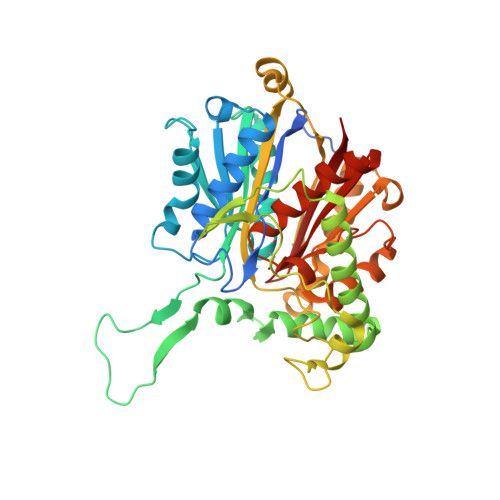The Crystal Structure of Human Mitochondrial 3-Ketoacyl-Coa Thiolase (T1): Insight Into the Reaction Mechanism of its Thiolase and Thioesterase Activities
Kiema, T.-R., Harijan, R.K., Strozyk, M., Fukao, T., Alexson, S.E.H., Wierenga, R.K.(2014) Acta Crystallogr D Biol Crystallogr 70: 3212
- PubMed: 25478839
- DOI: https://doi.org/10.1107/S1399004714023827
- Primary Citation of Related Structures:
4C2J, 4C2K - PubMed Abstract:
Crystal structures of human mitochondrial 3-ketoacyl-CoA thiolase (hT1) in the apo form and in complex with CoA have been determined at 2.0 Å resolution. The structures confirm the tetrameric quaternary structure of this degradative thiolase. The active site is surprisingly similar to the active site of the Zoogloea ramigera biosynthetic tetrameric thiolase (PDB entries 1dm3 and 1m1o) and different from the active site of the peroxisomal dimeric degradative thiolase (PDB entries 1afw and 2iik). A cavity analysis suggests a mode of binding for the fatty-acyl tail in a tunnel lined by the Nβ2-Nα2 loop of the adjacent subunit and the Lα1 helix of the loop domain. Soaking of the apo hT1 crystals with octanoyl-CoA resulted in a crystal structure in complex with CoA owing to the intrinsic acyl-CoA thioesterase activity of hT1. Solution studies confirm that hT1 has low acyl-CoA thioesterase activity for fatty acyl-CoA substrates. The fastest rate is observed for the hydrolysis of butyryl-CoA. It is also shown that T1 has significant biosynthetic thiolase activity, which is predicted to be of physiological importance.
Organizational Affiliation:
Faculty of Biochemistry and Molecular Medicine, Biocenter Oulu, University of Oulu, PO Box 3000, FIN-90014 Oulu, Finland.

















